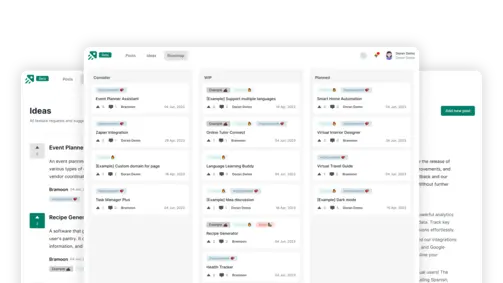What is CES survey? Typical Questions With Examples
Create changelog and product roadmap for your product
Explore nowTable of contents 9 min
The Customer Effort Score (CES) is a noteworthy instrument in the field of customer experience metrics that evaluates how easy it is for customers and businesses to communicate. For businesses looking to increase customer satisfaction and loyalty, it’s critical to grasp what CES surveys comprise, examine typical survey questions with real-world examples, and appreciate their place in contemporary business strategy.
What is a CES (Customer Effort Score) Survey?

Let’s first answer the question: “What is CES survey?”. A CES survey is a structured assessment used by businesses to measure the level of effort customers have to exert while engaging with a company. This metric provides insights into the ease or difficulty of various touchpoints in a customer’s journey, such as customer service interactions, product purchases, or website navigation. By employing CES surveys, companies aim to understand customer satisfaction based on the simplicity or complexity of their experiences.
Find out more: Boost Customer Satisfaction with Feedback Management
Why is CES Important for Business?
High levels of effort from customers can point to areas that require improvement, including complicated procedures or poor customer service. By identifying areas that require development, measuring CES not only offers insightful information about your customer journey but also acts as a drive for improvement.
CES Predicts Future Customer Purchasing Behavior
The easier it is to buy something, the more likely a customer is to return. A study published in the Harvard Business Review found that a good customer effort score (low effort) is one of the strongest predictors of future purchasing behavior: 94% of customers with low effort score indicates they are likely to buy the product again.
CES indicates the Likelihood of Customers Recommending to others
Easy transactions and interactions are great factors that make customers recommend and speak well of your business, otherwise they will say bad things about you. Harvard Business Review research also shows that 81% of customers said they would say negative things to others about a company that makes them work hard to experience the product or service.
CES Predicts Customer Loyalty
An article in Harvard Business Review with the provocative title “Stop trying to please your customers” – this article argues that besides a reliable service, customers want an easy experience rather than being given special privileges. A study shows that 96% of customers who experience high effort will not be loyal to that product or brand.
If an organization is experiencing poor customer satisfaction, customer effort scores can be used to evaluate problem areas within the company. After discovering where your customers have to put in the most effort, you can start to fix these areas to reduce your customers’ efforts. This will help increase customer satisfaction over time.
How to Calculate CES
CES = Total review score / Total number of surveys.
CES is a measure from the customer’s perspective and usually only asks a single question: “How much effort did you have to spend to do A with our company?”. On a scale of 1 to 7, level 1 is very difficult, level 7 is very easy.
-
CES from 0-3: Poor customer experience
-
CES from 4-5: Normal experience
-
CES from 6-7: Good experience
The higher the CES index, the less effort it takes for customers and the better the customer experience.
For example: When you survey the level of effort customers spend to use your products or services, the results are: you have 10 customers giving 1 point, 9 customers giving 2 points, 8 Customers giving 3 points. points, 17 customers give 4 points, 30 customers give 5 points, 21 customers give 6 points and 18 customers give 7 points then your CES will be calculated as follows:
CES results: (10*1 + 9*2 + 8*3 + 17*4 + 30*5 + 21*6 + 18*7) / (10 + 9 + 8 + 17 + 30 + 21 + 18) = 522/113 = 4.62
So the CES index is 4.62 points, the purchasing process and customer experience are at an average level, not really easy. You need to research and find problems to improve.
CES Surveying Methodology
CES surveys are typically conducted through questionnaires designed to evaluate customer experiences across different interaction points. These surveys may be deployed after specific customer interactions or transactions, allowing businesses to collect feedback on the level of effort customers had to put in during those instances.
Typical CES Survey Questions
Service Interaction: “On a scale of 1 to 7, how much effort did you have to exert to resolve your issue with our customer support team?”
Purchase Experience: “How easy was it for you to find and buy the product/service you were looking for?”
Website Usability: “Did you find our website navigation intuitive and user-friendly?”
Resolution Time: “Were your concerns addressed promptly and without much effort on your part?”
Overall Satisfaction: “Would you say that your experience with our company required more effort than expected?”
More to read: 30 Must-have Customer Feedback Survey Questions
Examples of CES Survey Questions

CES survey example 1: Service Interaction
Question: “Rate the effort required to resolve your query with our support team on a scale of 1 to 7.”
Response: “I would rate it as a 2; the support team swiftly resolved my issue with minimal effort on my part.”
CES survey example 2: Purchase Experience
Question: “How easy was it for you to find and purchase the product/service you intended to buy?”
Response: “The process was quite straightforward; I easily found what I needed and made the purchase within minutes.”
CES survey example 3: Website Usability
Question: “Did you find our website user-friendly and easy to navigate?”
Response: “The website was intuitive, and I quickly found the information I was seeking without any hassle.”
CES survey example 4: Resolution Time
Question: “Were your concerns resolved promptly without requiring too much effort from your end?”
Response: “I had my issue sorted within a short period, and the resolution process was hassle-free.”
CES survey example 5: Overall Satisfaction
Question: “Do you feel that interacting with our company required more effort than you anticipated?”
Response: “The overall experience was smooth, and it didn’t demand more effort than I expected.”
Significance of CES Surveys
CES surveys hold immense significance for businesses aiming to enhance customer satisfaction and retention. By collecting feedback on the level of effort customers have to invest, companies can identify pain points in their processes, improve efficiency, and streamline interactions to ensure a smoother customer journey.
Leveraging CES Surveys for Business Growth
CES surveys ought to be distributed right away following encounters or certain touchpoints, such as a product purchase or a customer support interaction. Asking a consumer how simple it was to have their problem fixed during their interaction with your business can tell you if they will do business with you again. In order to better understand how to enhance or close the loop on the engagement, you might go one step further and inquire as to why they evaluated the encounter as easy or tough in the survey.
Considerations for creating CES surveys:
-
Optimize for Mobile: Since mobile devices account for over half of all online interactions, your survey needs to be mobile-friendly. The positive options should be at the top, and the bad ones should be at the bottom. Any unnecessary content, such as logos, needless text, and external links, should be removed.
-
Automated Triggers: Following a particular touchpoint or conversation with a customer care agent, surveys ought to be distributed automatically. It is possible to set up automatic triggers with software such as Qualtrics, eliminating the need for human survey distribution.
-
Keep it Simple: There should only be one or two questions in the survey, and no leading questions should be included.
-
Share Your Data: Leadership from various departments should work together to implement a strategy, and results should be communicated to those who can take appropriate action. Furthermore, customer support agents must have the authority to get in touch with customers again and address any problems that weren’t resolved during the initial exchange.
Common Strategies for Raising Your Company’s CES Score

CES surveys hold immense significance for businesses aiming to enhance customer satisfaction and retention. By collecting feedback on the level of effort customers have to invest, companies can identify pain points in their processes, improve efficiency, and streamline interactions to ensure a smoother customer journey.
Consumers prefer simple transactions, and if they are having trouble getting their questions answered, they will move to another provider. By using a handful of the tools listed below, you can instantly improve your CES.
Offer a Variety of Contact and Feedback Channels
Your company should interact with clients across all digital support channels, allowing them to select the one in which they are most at ease. Popular choices include call centers, email, chat, social media assistance, and in-person support centers.
Use Self-service Tools
A lot of consumers would like to handle problems on their own rather than contacting customer support. You may minimize consumer effort and make it simpler for customers to get their questions answered by offering self-service choices. Self-help books and forms are excellent places to start.
Cut down on Wait Times
Consumers prefer speedy resolution of their problems over long phone waits to speak with live agents. Use a callback system or hire more workers during your busiest hours if your wait times are excessive.
When a customer is dissatisfied, it’s critical to address their concerns and make sure they completely understand what you may do to win back their business. Based on the whole poll results, you should also enhance your products or customer service department generally.
Customer Effort Score (CES) surveys are instrumental in assessing the ease of customer interactions with a business. Through strategically designed questions focused on touch points across the customer journey, CES surveys provide valuable insights into customer satisfaction levels based on the effort required. Understanding the significance of CES surveys, their typical questions, and leveraging the obtained data empower businesses to refine their processes, enhance customer experiences, and nurture long-term customer loyalty.
What to not miss out on our blog
Gain insightful knowledge and invaluable experiences from dedicated experts.

CRM System Explained: Benefits, Types, and How It Works
Discover everything about CRM system. Learn the benefits and how a CRM system works to improve customer relationships and streamline business operations.

Are you ready? Start your free trial today.
Enhance communication, keep track of the progress, understand customers' insight and more by taking your first trial on Doran.
Sign up for free

